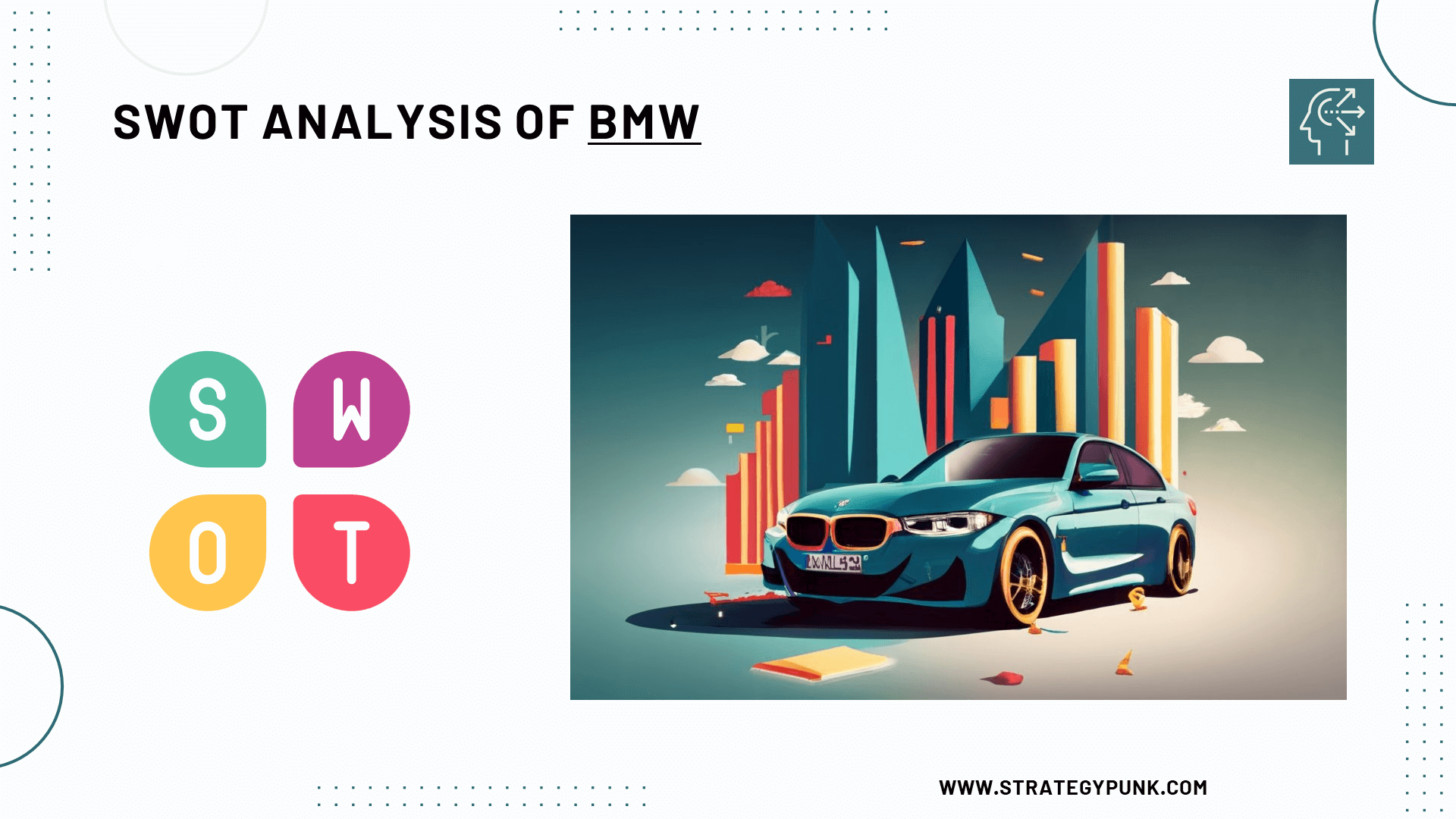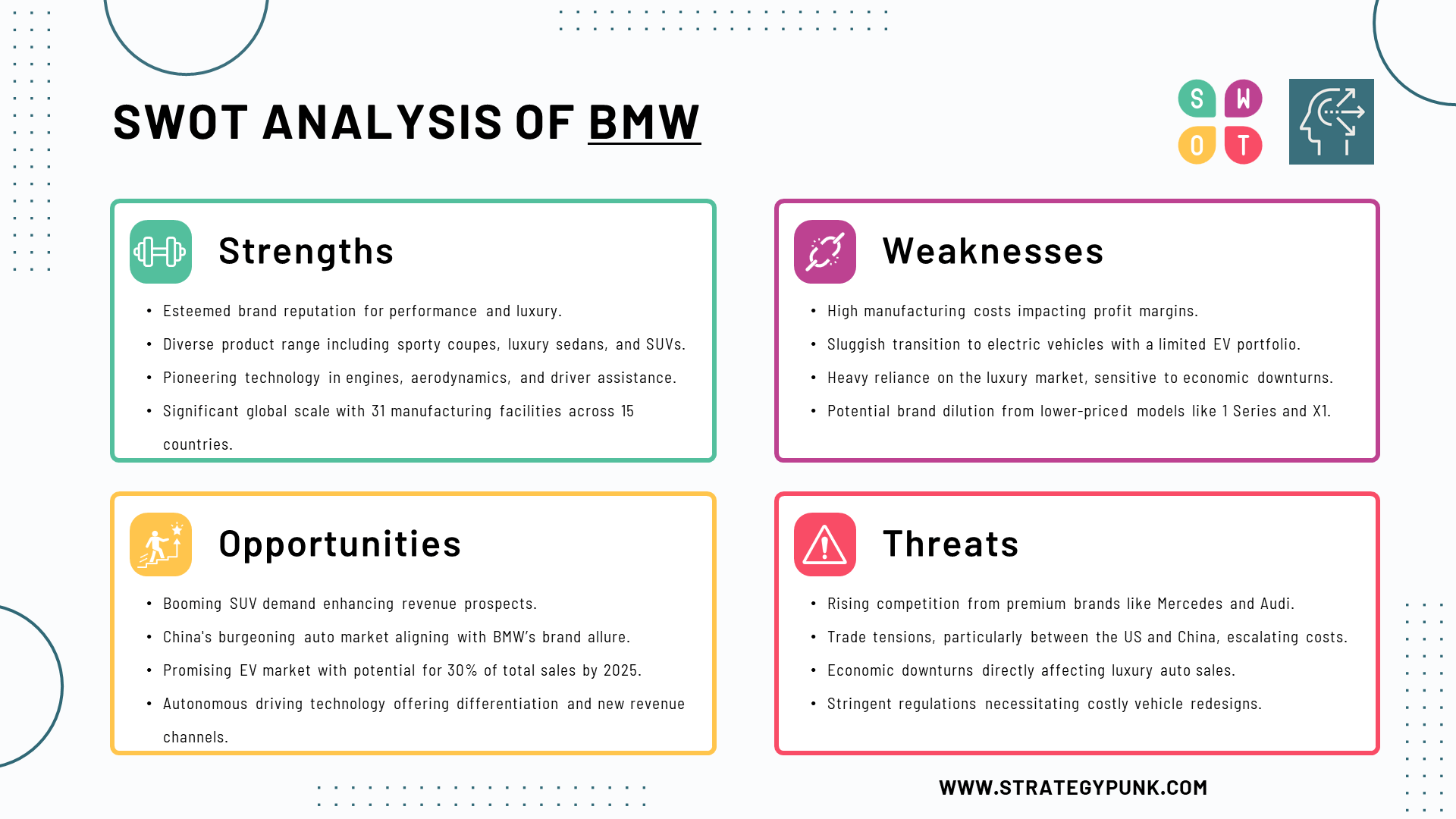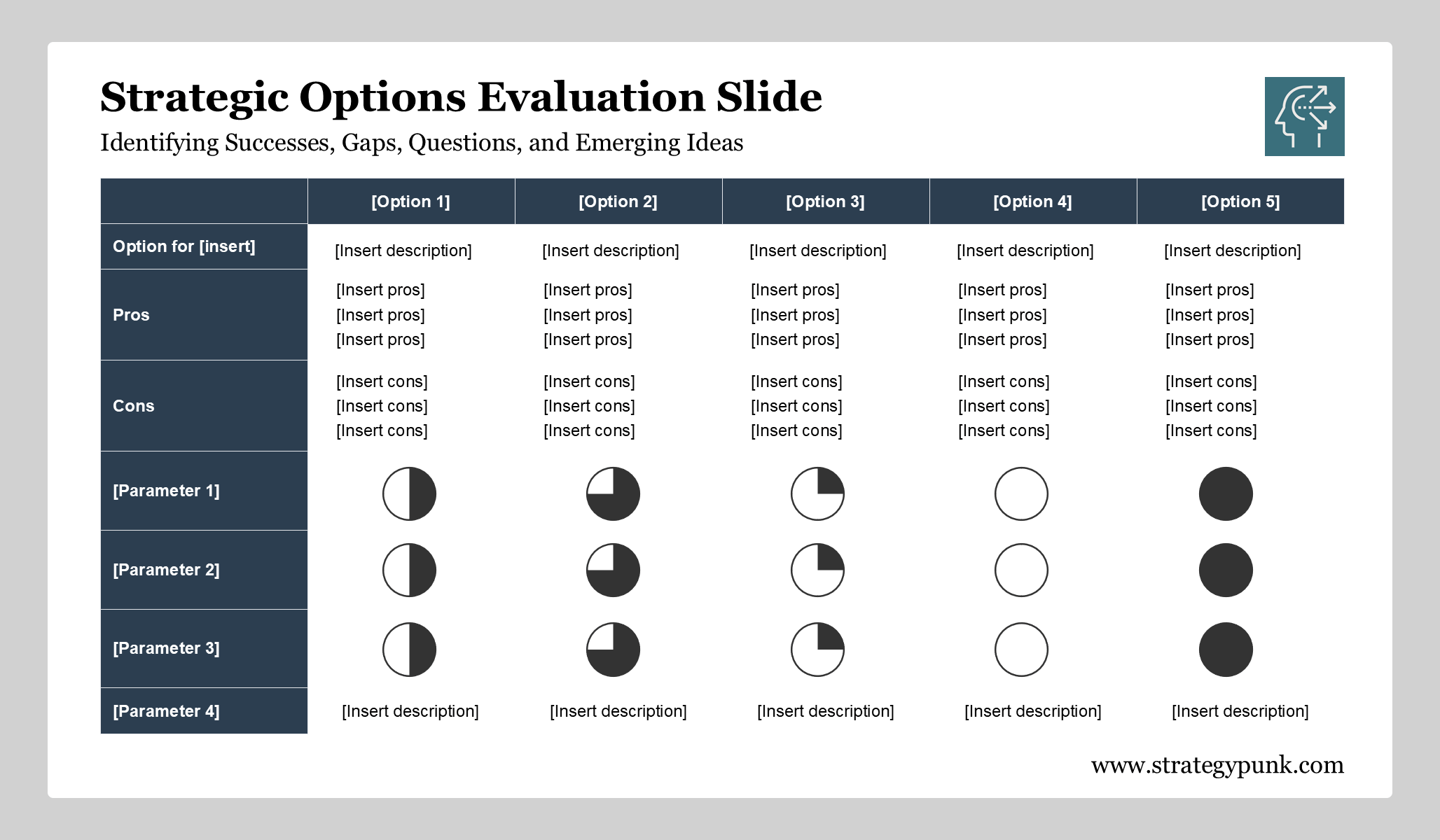SWOT Analysis of BMW: Free PPT Template and In-Depth Insights 2024
Dive deep into BMW's SWOT Analysis with our free PPT template and detailed insights for 2024. Explore BMW's strengths, such as its revered brand reputation and cutting-edge technology, alongside its weaknesses, such as a limited EV portfolio.

SWOT Analysis of BMW
Insights into the Strengths, Weaknesses, Opportunities, and Threats Facing the Automaker.
BMW is one of the most iconic automotive brands in the world, known for its luxury vehicles, performance pedigree, and cutting-edge technology.
But like any company, BMW has its share of strengths and weaknesses, as well as opportunities and threats, to consider as it charts its future strategic course.
This post examines BMW through the lens of a SWOT analysis.

Strengths
- Strong brand reputation: BMW has cultivated a powerful brand image centered around performance, luxury, and driving enjoyment. This gives it pricing power and strong customer loyalty.
- Product portfolio: BMW offers a diverse product mix ranging from sporty coupes to luxury sedans to SUVs under brands like BMW, Mini, and Rolls-Royce. This variety caters to different consumer tastes and price points.
- Cutting-edge technology: BMW is known for innovation, especially in engines, aerodynamics, and driver assistance features. This focus on advanced tech provides a competitive advantage.
- Global scale: With 31 manufacturing facilities in 15 countries, BMW has achieved substantial global scale and scope. This helps with cost efficiencies and market access.
Weaknesses
- High costs: BMW vehicles are expensive to manufacture, given their premium materials, complex engineering, and low production volumes. This pressures profit margins.
- Limited EV portfolio: BMW has been slower to electrify than its rivals. Its current EV lineup is limited, putting it at a disadvantage as EVs gain market share.
- Reliance on the luxury market: Most of BMW's sales come from luxury vehicles, vulnerable to economic downturns when discretionary spending drops.
- Brand dilution risks: Expanding into lower price segments with models like the 1 Series and X1 could dilute BMW's upmarket brand image over time.
Opportunities
- Growing SUV demand: SUVs are BMW's most profitable models. Rising SUV sales present an opportunity to grow revenues and margins.
- China's expanding auto market: China is BMW's largest market. Its growing middle class presents an attractive target market for BMW's aspirational brand image.
- Electric vehicles: Forecasts suggest EVs could make up over 30% of BMW's total sales by 2025. BMW can capitalize on this trend with new EV models.
- Autonomous driving: Self-driving technology presents opportunities for BMW to differentiate its models and open new revenue streams through connected services.
Threats
- Intensifying competition: Premium rivals like Mercedes and Audi directly target BMW's affluent consumer base with competitive offerings.
- Trade tensions: Import tariffs and trade disputes, especially between the US and China, could raise costs and hurt BMW's sales.
- Economic conditions: Luxury auto sales are strongly tied to economic cycles. A recession could materially impact BMW's revenues and margins.
- Regulations: Tighter emissions rules, fuel economy standards, and bans on ICE vehicles in some cities could force costly vehicle redesigns.
BMW possesses substantial strengths, from its brand equity to its technology expertise, but faces risks from market shifts and competitive forces.
By leveraging opportunities like EVs and China while shoring up weaknesses around costs and its EV lineup, BMW can remain an auto industry leader.
Frequently Asked Questions
Brand Image and Loyalty
How has BMW's strong brand image contributed to its market positioning within the luxury automotive segment?
BMW's robust brand image as a purveyor of luxury, performance, and cutting-edge technology has significantly contributed to its esteemed position within the luxury automotive segment.
The brand's image resonates with consumers who value driving pleasure, engineering excellence, and a status symbol.
BMW's ability to maintain a strong brand identity over the years has not only facilitated a loyal customer base but also allowed for premium pricing of its products, thereby enhancing its market positioning and profitability.
What strategies has BMW employed to foster customer loyalty, and how effective have these strategies been?
To foster customer loyalty, BMW has employed various strategies, including offering high-quality vehicles, personalized services, loyalty programs, and engaging marketing campaigns.
The effectiveness of these strategies is reflected in BMW's substantial customer retention rates and the premium consumers are willing to pay for the perceived value and quality associated with BMW products.
Furthermore, BMW's investment in creating an unparalleled driving experience and innovative technologies has significantly contributed to building and maintaining customer loyalty.
Product Portfolio Diversity
How has BMW's diverse product portfolio helped cater to different market segments?
BMW's diverse product portfolio, ranging from sporty coupes to luxury sedans and SUVs under brands like BMW, Mini, and Rolls-Royce, allows it to cater to various consumer tastes and price points.
This diversity not only helps in reaching different market segments but also mitigates risks associated with over-reliance on a particular vehicle segment.
The multi-brand strategy enables BMW to offer products that cater to the mass market, luxury, and ultra-luxury segments, thereby broadening its market reach and potential revenue streams.
What are the risks and rewards associated with BMW's multi-brand strategy encompassing BMW, Mini, and Rolls-Royce?
The risks of BMW's multi-brand strategy include potential brand dilution and increased operational complexity. For instance, introducing lower-priced models might dilute BMW’s upmarket brand image.
Moreover, managing multiple brands with distinct identities and customer bases requires significant investment and strategic focus, which could stretch resources and impact the coherence of brand messaging. However, the rewards in terms of market penetration and revenue diversification could outweigh these risks if managed effectively.
Technological Innovation
How does BMW's cutting-edge technology compare to that of its competitors?
BMW has always been at the forefront of technological innovation in the automotive industry, especially in engine technology, aerodynamics, and driver assistance features. This technical prowess not only enhances BMW’s market share but also significantly bolsters its competitiveness against rivals.
The continuous investment in R&D enables BMW to offer state-of-the-art vehicles that appeal to tech-savvy consumers and those who prioritize performance and safety.
What impact has BMW's focus on innovation had on its market share and overall competitiveness?
The impact of BMW’s focus on innovation is profound. It's not only about maintaining a competitive edge but also about setting industry standards in many technological domains.
By staying ahead in the innovation curve, BMW ensures its relevancy in a rapidly evolving industry, which in turn helps in sustaining and growing its market share.
Moreover, innovative technologies like autonomous driving and electric powertrains are becoming crucial differentiators in the automotive market, further emphasizing the importance of BMW's technological advancements.
Global Operations and Scale
What challenges and advantages has BMW encountered by operating on a global scale?
Operating globally provides BMW significant advantages, notably access to various markets, economies of scale, and a diversified revenue base. It enables BMW to absorb regional economic fluctuations better and leverage global supply chains to optimize costs.
However, it also presents challenges such as managing a complex, global supply chain, adhering to different regulatory requirements, and navigating geopolitical tensions that might disrupt operations or incur additional costs.
How does BMW's global manufacturing footprint contribute to its ability to meet demand in different markets?
BMW's global manufacturing footprint, spread across 31 facilities in 15 countries, significantly enhances its ability to meet market demand.
By strategically locating its manufacturing facilities close to key markets, BMW can reduce shipping times and costs, respond more quickly to market trends, and better cater to local preferences.
Additionally, a global footprint allows for optimizing production capacities, ensuring a steady supply of vehicles, and minimizing the risks associated with over-reliance on a single region.
Electrification and EV Portfolio
What steps is BMW taking to expand its electric vehicle (EV) lineup to compete in the growing EV market?
BMW has acknowledged the shift towards electric vehicles (EVs) and has initiated steps to expand its EV lineup.
These steps include investments in EV technology, the development of new EV models, and collaborations with battery manufacturers.
However, compared to some competitors, BMW's transition to electrification has been perceived as cautious, which may be part of a balanced approach to managing risks associated with new technologies.
How might BMW's slow transition to electrification impact its market share and brand reputation?
BMW’s transition to electrification has been perceived as slow, especially compared to competitors like Tesla and Audi.
This sluggish transition might affect its market share as consumers increasingly prefer electric vehicles (EVs) due to their lower operating costs and environmental benefits.
Moreover, as governments worldwide are setting strict emission standards, BMW’s delay might also tarnish its brand reputation, which has been traditionally associated with innovation and leadership in automotive technology.
However, BMW has been ramping up its efforts recently to catch up in the EV race, which might help restore its brand image and market position.
Luxury Market Dependence
How does BMW's reliance on the luxury market affect its financial stability during economic downturns?
BMW’s strong foothold in the luxury market can be a double-edged sword. During economic downturns, high-end products often witness a decline in sales as consumers cut back on discretionary spending. BMW’s financial stability could be affected in such scenarios.
Are there strategies BMW could adopt to mitigate risks associated with economic fluctuations?
To mitigate these risks, diversifying its product line to include more affordable models or venturing into new markets could be beneficial.
Additionally, BMW could also consider investing in emerging automotive technologies or partnerships to spread out its financial risks and ensure a steady revenue stream.
Market Expansion and Emerging Markets
What strategies is BMW employing to capitalize on the growing automotive market in China?
BMW has been actively pursuing the Chinese market, a critical growth area due to its size and the increasing demand for premium vehicles.
However, geopolitical tensions like trade disputes could pose significant challenges.
How might geopolitical tensions, such as trade disputes, impact BMW's market expansion strategies?
Tariffs and trade restrictions could increase operational costs and affect BMW’s pricing strategy in these markets.
BMW must have a robust contingency plan to navigate such geopolitical hurdles, including forming local partnerships or adjusting its supply chain strategies.
Autonomous Driving and Connected Services
What are BMW's plans for autonomous driving, and how do they compare to industry standards or competitors’ strategies?
BMW’s plans for autonomous driving are ambitious and centered around its iNEXT project, which aims to bring Level 3 autonomy to its vehicles. Comparatively, BMW is on par with its competitors regarding technological advancements but might need to accelerate its efforts to keep pace with industry leaders like Waymo and Tesla.
How might autonomous driving technology open up new revenue streams for BMW?
The venture into autonomous driving technology opens up various revenue streams for BMW, including subscription-based services, data monetization, and new mobility solutions, which could significantly contribute to its financial stability in the long run.
Regulatory Compliance
How is BMW adapting to the evolving regulatory landscape, particularly around emissions and fuel economy standards?
Regulatory compliance, particularly around emissions and fuel economy standards, is a pressing concern for BMW.
The company has invested in electric and hybrid models to adhere to the tightening global emission standards.
What impact might tighter emissions regulations have on BMW’s product development and market strategy?
This transition not only helps in regulatory compliance but also aligns BMW with the market shift towards eco-friendly vehicles.
However, it requires a substantial investment in R&D, which might affect its market strategy and product development timelines.
Competitive Dynamics
How is BMW positioned against its direct competitors like Mercedes and Audi regarding market share, brand perception, and technological innovation?
In the competitive landscape, BMW is positioned firmly against its direct competitors like Mercedes and Audi, although the fierce competition demands continuous innovation.
What strategies could BMW employ to maintain or enhance its competitive position in the premium automotive market?
To maintain or enhance its competitive position, BMW could focus on technological advancements, customer-centric services, and strategic partnerships.
Moreover, accelerating its electrification and autonomous driving initiatives could also give BMW a competitive edge in the premium automotive market, ensuring its sustained growth and profitability amidst the evolving industry dynamics.
BMW SWOT Analysis PowerPoint Template
free and fully editable ppt template
A SWOT analysis evaluates the strengths, weaknesses, opportunities, and threats impacting a company.
This free editable PowerPoint template provides a SWOT analysis framework to evaluate BMW's internal strengths and weaknesses and external opportunities and threats.






